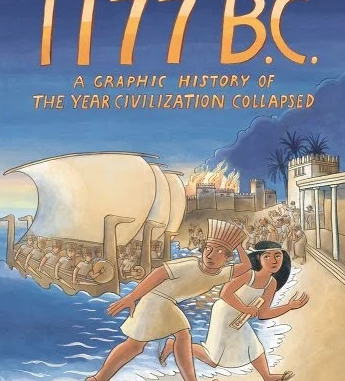
By T’Neil Gooden
The Ethyle R. Wolfe Institute for the Humanities along with the Departments of Classics, History, and Anthropology at Brooklyn College hosted “When Societies Collapse: How an Archaeologist and Graphic Novelist Explain Big Topics to New Audiences” on Thursday, Sept. 12. This event was a deep dive into the addition of an accompanying graphic novel to the 2014 book “1177 B.C.: The Year Civilization Collapsed” by Eric H. Cline.
Speakers of the function included Professor Liv Yarrow, the chair of the Classics Department, Eric H. Cline, the author of the 2014 book, and Glynnis Fawkes, the illustrator of the graphic novel.
“1177 B.C. by Eric H. Cline” focuses on the cause of the collapse of the Late Bronze Age. The Late Bronze Age is defined as a time of widespread societal collapse in the Eastern Mediterranean during the 12th century BC. Cline began the event by explaining the history of the Last Bronze Age and explained that the collapse was not caused by an individual incident, but was caused by the sea people (a group of tribes that attacked the Mediterranean during the Late Bronze Age), drought, famine, invaders, earthquakes, and diseases.
“You have a system collapse, everything goes down, central administration, centralized economy, and the one percent go away,” Cline said. “[The one percent] either died or they migrated, and you basically have to start all over again.”
This collapse did not just occur in a year: the fall of the Late Bronze Age happened over an entire century. Cline and editor of the graphic novel Rob Tempio wanted to portray this story in a new light. The book was revised and republished in 2021, leading them to think about creating a history book that contains graphics for all individuals of different ages to enjoy. This is how Glynnis Fawkes entered the creation of the 2024 graphic edition of the book.
“We knew we got along, and I also knew that she was an absolutely brilliant cartoonist, as well as a great archeologist,” Cline said. “I’m like it was a perfect match made in heaven […] I’m like [Glynnis] translated this language into a cartoon.”
Cline finished his speech and introduced Glynnis Fawkes to the audience. Fawkes is an archaeologist and author-illustrator who has written, illustrated, and worked on many books such as “Charlotte Bronte Before Jane Eyre” and “Persephone’s Garden.” Doing the illustration for “1177 B.C.” was a story that she knew she wanted to illustrate.
“All those stories […] I wanted to find all the stories of these characters and to dramatize them,” Fawkes said. “That is what made me say, ‘Yes, I want to do this project, draw these characters and their situations that they got into.’”
Before explaining the process behind creating the illustration for the book, Fawkes, and BC student, Sarah Maria Dos Santos, read an excerpt of the book for the audience to hear and see the visuals encompassed in the pages. After the reading, Fawkes went into the work behind creating the visuals that the audience and readers got to view.
First, Fawkes gets what she calls “dirty paper,” where she draws and shades in pencil the characters and backgrounds that she can erase. When the shading and characters have been approved by Cline, Fawkes moves on to working on “clean paper,” which is a clean sheet of paper that she is not allowed to erase. After that has been approved, Fawkes scans the clean paper onto an iPad where she then uses three different software: Procreate, Photoshop, and InDesign to add captions and facial expressions to the characters and pages.
“I didn’t want to make [the graphic book] seem sort of like a TED Talk,” Fawkes said. “I really wanted the ancient characters to be foremost and to speak as much as possible.”
Within the reading provided to the audience, Fawkes added humor and complexity to her characters. She explained she was influenced by her teenage sons, as the creation of these graphics was amid the COVID-19 pandemic.
“[The pandemic] gave some context to work on a book about the collapse of civilization, while you can’t leave your house,” Fawkes told the audience. “It just felt really relevant.”
Cline is just getting started. With plans to continue drawing historic graphic novels–starting with 776 BC about Alexander the Great–everyone can continue to learn history in a fun and engaging way.
Students interested in reading more from Eric H. Cline can find his books in Princeton University Press and students interested in upcoming talks can visit the BC Wolfe Institute on their Instagram, @bc_wolfeinstitute
